The NVIDIA GeForce GTX 1650 Review, Feat. Zotac: Fighting Brute Force With Power Efficiency
by Ryan Smith & Nate Oh on May 3, 2019 10:15 AM ESTBattlefield 1 (DX11)
Battlefield 1 returns from the 2017 benchmark suite, the 2017 benchmark suite with a bang as DICE brought gamers the long-awaited AAA World War 1 shooter a little over a year ago. With detailed maps, environmental effects, and pacy combat, Battlefield 1 provides a generally well-optimized yet demanding graphics workload. The next Battlefield game from DICE, Battlefield V, completes the nostalgia circuit with a return to World War 2, but more importantly for us, is one of the flagship titles for GeForce RTX real time ray tracing.
We use the Ultra, High, and Medium presets is used with no alterations. As these benchmarks are from single player mode, our rule of thumb with multiplayer performance still applies: multiplayer framerates generally dip to half our single player framerates. Battlefield 1 also supports HDR (HDR10, Dolby Vision).
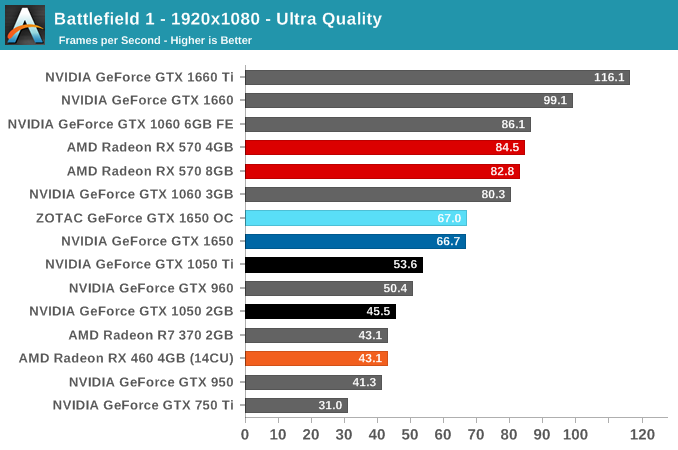
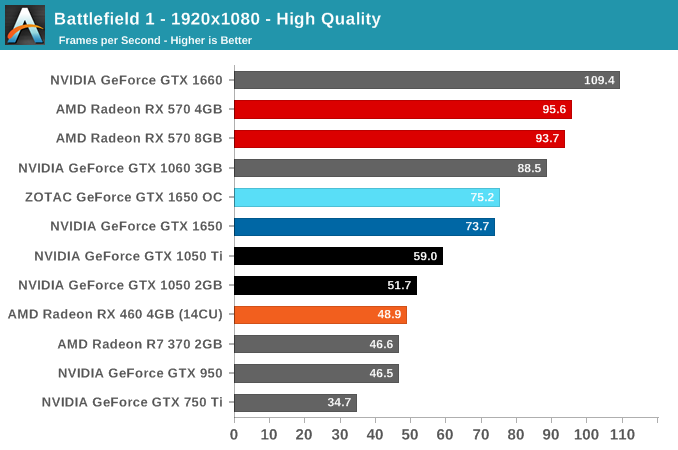
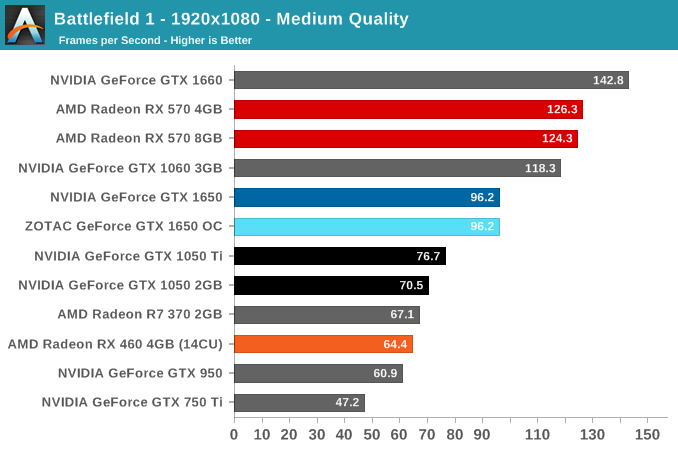

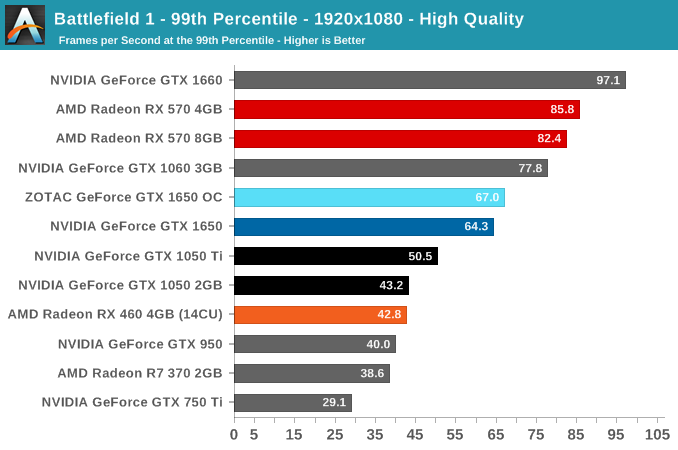
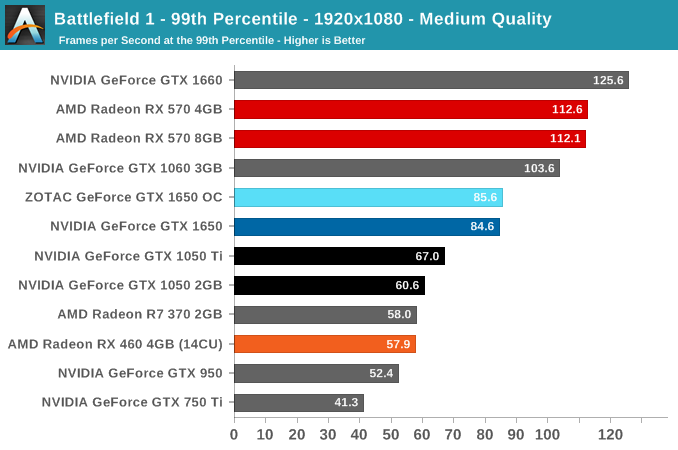
Without a direct competitor in the current generation, the GTX 1650's intended position is somewhat vague, outside of iterating on Pascal's GTX 1050 variants. Looking back to Pascal's line-up, the GTX 1650 splits the difference between the GTX 1050 Ti and GTX 1060 3GB, and far from the GTX 1660.
Compared to the RX 570 though, the GTX 1650 is handily outpaced, and Battlefield 1 where the GTX 1650 is the furthest behind. That being said, the RX 570 wasn't originally in this segment, with price being the common denominator. The RX 460, meanwhile, is well-outclassed, and the additional 2 CUs in the RX 560 would be unlikely to significantly narrow the gap.
As for the ZOTAC card, the 30 MHz is an unnoticable difference in real world terms.











126 Comments
View All Comments
Marlin1975 - Friday, May 3, 2019 - link
Not a bad card, but it is a bad price.drexnx - Friday, May 3, 2019 - link
yep, but if you look at the die size, you can see that they're kinda stuck - huge generational die size increase vs GP107, and even RX570/580 are only 232mm2 compared to 200mm2.I can see how AMD can happily sell 570s for the same price since that design has been long paid for vs. Turing and the MFG costs shouldn't be much higher
Karmena - Tuesday, May 7, 2019 - link
Check the prices of RX570, they cost 120$ on newegg. And you can get one under 150$tarqsharq - Tuesday, May 7, 2019 - link
And the RX570's come with The Division 2 and World War Z right now.You can get the ASrock version with 8GB VRAM for only $139!
0ldman79 - Sunday, May 19, 2019 - link
Problem is on an OEM box you'll have to upgrade the PSU as well.Dealing with normies for customers, the good ones will understand, but most of them wouldn't have bought a crappy OEM box in the first place. Most normies will buy the 1650 alone.
AMD needs 570ish performance without the need for auxiliary power.
Yojimbo - Friday, May 3, 2019 - link
Depending on the amount of gaming done, it probably saves over 50 dollars in electricity costs over a 2 year period compared to the RX 570. Of course the 570 is a bit faster on average.JoeyJoJo123 - Friday, May 3, 2019 - link
Nobody in their right mind that's specifically on the market for an aftermarket GPU (a buying decision that comes about BECAUSE they're dissatisfied with the current framerate or performance of their existing, or lack of, a GPU) is making their primary purchasing decision on power savings alone. In other words, people aren't saying "Man, my ForkNight performance is good, but my power bills are too high! In order to remedy the exorbitant cost of my power bill, I'm going to go out and purchase a $150 GPU (which is more than 1 month of my power bill alone), even if it offers the same performance of my current GPU, just to save money on my power bill!"Someone might make that their primary purchasing decision for a power supply, because outside of being able to supply a given wattage for the system, the only thing that matters is its efficiency, and yes, over the long term higher efficiency PSUs are better built, last longer, and provide a justifiable hidden cost savings.
Lower power for the same performance at a similar enough price can be a tie-breaker between two competing options, but that's not the case here for the 1650. It has essentially outpriced itself from competing viably in the lower budget GPU market.
Yojimbo - Friday, May 3, 2019 - link
I don't know what you consider being in a right mind is, but anyone making a cost sensitive buying decision that is not considering total cost of ownership is not making his decision correctly. The electricity is not free unless one has some special arrangement. It will be paid for and it will reduce one's wealth and ability to make other purchases.logamaniac - Friday, May 3, 2019 - link
So I assume you measure the efficiency of the AC unit in your car and how it relates to your gas mileage over duration of ownership as well? since you're so worried about every calculation in making that buying decision?serpretetsky - Friday, May 3, 2019 - link
It doesn't really change the argument if he does or does not take into account his AC unit in his car. Electricity is not free. You can ignore the price of electricity if you want, but your decision to ignore it or not does not change the total cost of ownership. (I'm not defending the electricity calculations above, I haven't verified them)